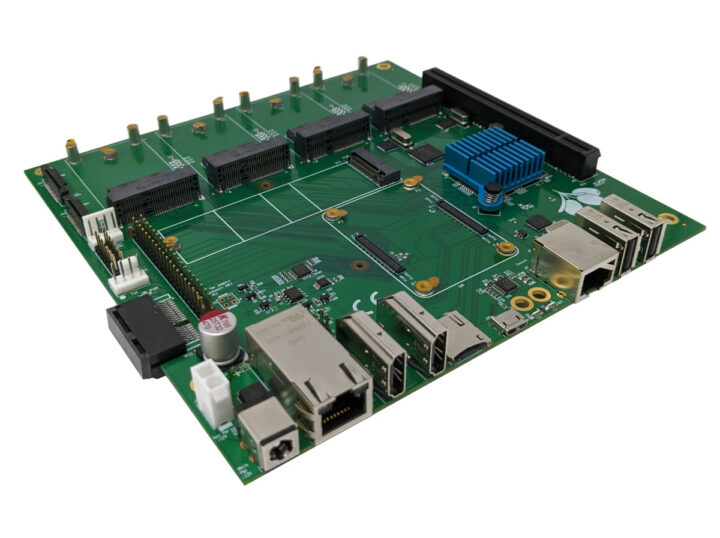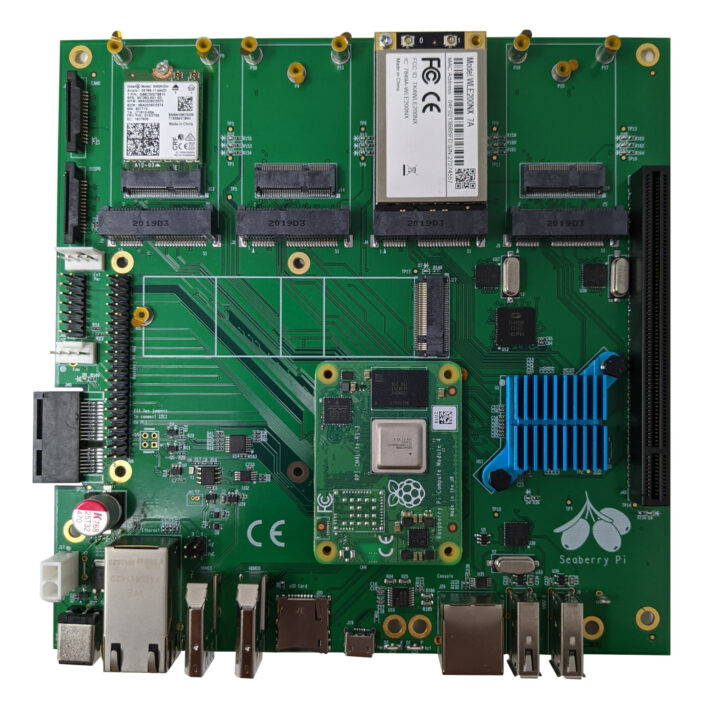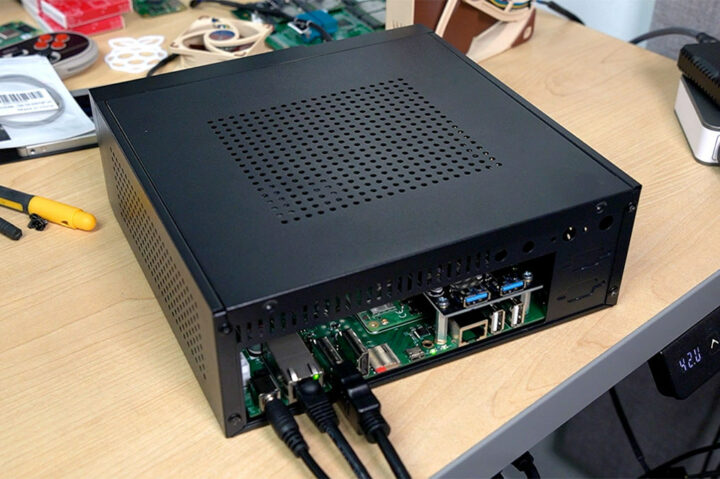The Raspberry Pi CM4 may only have a one PCIe x1 Gen 2 interface, but this has not stopped ALFTEL from designing Seaberry, a mini-ITX carrier board for the Raspberry Pi Compute Module 4 with eleven slots and sockets making use of the single 5 Gbps PCIe Gen 2 interface.
The board also offers two SATA ports, one Gigabit Ethernet port, one RJ45 console port, two HDMI ports, a micro SD card slot, two USB 2.0 ports, as well as the usual 40-pin GPIO expansion header, besides the PCIe x16 slot, a PCIe x1 side slot, and M.2 and mPCIe sockets.
 Seaberry carrier board specifications:
Seaberry carrier board specifications:
- Compatible systems-on-module
- Storage – 1x MicroSD card for Raspberry Pi CM4 Lite, 1x M.2 socket for NVMe SSD (See PCIe expansion section)
- Video Output – 2x HDMI output ports, 1x MIPI DSI connector
- Camera Input – 1x MIPI CSI connector
- Networking – Gigabit Ethernet RJ45 port capable of PoE 802.3bt (100 W) power input handling
- USB
- 2x USB 2.0 ports
- 1x micro USB port to program regular Raspberry Pi CM4 modules with eMMC flash
- PCIe expansion
- 1x 16-lane size vertical PCIe connector with x1 lane implementation in the standard Mini-ITX location
- 1x 1-lane PCIe side port connector to allow to plug a standard x1 PCIe add-on card on a left side
- 4x mini PCIe slots with PCIe, USB 2.0, and I2C interfaces
- 4x M.2 Key E slots with x2 (dual) PCIe lanes, USB 2.0 interfaces
- 1x M.2 Key M slot to allow M.2 2280 NVME SSD implementing x1 PCIe lane
- I/O expansion
- 40-pin GPIO header compatible with Raspberry Pi HAT expansion boards
- Additional I2C header
- Misc
- PWM fan connector
- RJ45 port implementing CISCO style RS232 serial console cable
- 2×7 row header for jumper-selected settings/controls
- RTC + external battery header
- Power Supply
- 12V DC input via power barrel jack and 2-pin header; mutually inclusive to support power failover
- SATA power header with 12V, 5V, GND
- 4-pin PoE header compatible with Raspberry Pi PoE HAT
- Dimensions – 170 x 170 mm (Mini-ITX form factor)
 The photo above gives a clearer idea of how the M.2 and mini PCIe sockets are arranged. The chip under the blue heatsink is the PCIe switch. It would have been nice to have the schematics or at least a block diagram to better understand how everything is implemented, but the current documentation on Github is rather limited. In any case, the board will probably only be useful for experimentation as the 5 Gbps bandwidth limit is not suitable for people looking for performance.
The photo above gives a clearer idea of how the M.2 and mini PCIe sockets are arranged. The chip under the blue heatsink is the PCIe switch. It would have been nice to have the schematics or at least a block diagram to better understand how everything is implemented, but the current documentation on Github is rather limited. In any case, the board will probably only be useful for experimentation as the 5 Gbps bandwidth limit is not suitable for people looking for performance.
Having said that, Jeff Geerling got an early sample and was able to test various PCIe cards successfully including an Intel i350 dual-gigabit LAN card, a KIOXIA XG6 M.2 NVMe SSD, a Compex WLE200NX 802.11n WiFi card, an Intel AX210 WiFi 6E card, and a dual SATA controller among others. He was less lucky with the dual-TPU Coral M.2 accelerator and a Radeon x16 graphics card, but the latter is not surprising at all since the PCIe implementations in most Arm processors have limitations, unless going into higher-end server or networking processors.

Since the board follows the mini-ITX standard, Jeff could also install it in an off-the-shelf PC case, namely Goodisory MX01. I’m not quite sure where the two USB 3.0 ports above the RJ45 console port and USB 2.0 ports are coming from… If you prefer video content, I’ve also embedded Jeff’s video at the end of this article.
Seaberry is listed on Tindie for $435 plus shipping and taxes. It is currently out of stock, but ALFTEL is expecting about 100 pieces in two to three weeks, so you could always join the waiting list on Tinie if you are interested.

Jean-Luc started CNX Software in 2010 as a part-time endeavor, before quitting his job as a software engineering manager, and starting to write daily news, and reviews full time later in 2011.
Support CNX Software! Donate via cryptocurrencies, become a Patron on Patreon, or purchase goods on Amazon or Aliexpress




